
Sukkot is a Torah-commanded holiday celebrated for seven days from the 15th day of the month of Tishrei. It is one of the Three Pilgrimage Festivals on which those Israelites who could were commanded to make a pilgrimage to the Temple in Jerusalem.
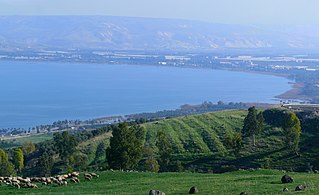
The Sea of Galilee, also called Lake Tiberias, Kinneret or Kinnereth, is a freshwater lake in Israel. It is the lowest freshwater lake on Earth and the second-lowest lake in the world, at levels between 215 metres (705 ft) and 209 metres (686 ft) below sea level. It is approximately 53 km (33 mi) in circumference, about 21 km (13 mi) long, and 13 km (8.1 mi) wide. Its area is 166.7 km2 (64.4 sq mi) at its fullest, and its maximum depth is approximately 43 metres (141 ft). The lake is fed partly by underground springs but its main source is the Jordan River, which flows through it from north to south and exits the lake at the Degania Dam.

The Negev or Negeb is a desert and semidesert region of southern Israel. The region's largest city and administrative capital is Beersheba, in the north. At its southern end is the Gulf of Aqaba and the resort city and port of Eilat. It contains several development towns, including Dimona, Arad and Mitzpe Ramon, as well as a number of small Bedouin towns, including Rahat and Tel Sheva and Lakiya. There are also several kibbutzim, including Revivim and Sde Boker; the latter became the home of Israel's first Prime Minister, David Ben-Gurion, after his retirement from politics.
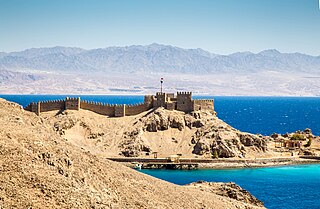
Taba is an Egyptian town near the northern tip of the Gulf of Aqaba. Taba is the location of Egypt's busiest border crossing with neighboring Eilat, Israel. Taba was originally developed as a tourist destination by the Israelis with the first hotel opening there in the 1960s, and today it is a frequent vacation spot for Egyptians and other tourists, especially those from Israel on their way to other destinations in Egypt or as a weekend getaway. It is the northernmost resort of Egypt's Red Sea Riviera.

The sand cat, also known as the sand dune cat, is a small wild cat that inhabits sandy and stony deserts far from water sources. With its sandy to light grey fur, it is well camouflaged in a desert environment. Its head-and-body length ranges from 39–52 cm (15–20 in) with a 23–31 cm (9.1–12.2 in) long tail. Its 5–7 cm (2.0–2.8 in) short ears are set low on the sides of the head, aiding detection of prey moving underground. The long hair covering the soles of its paws insulates its pads against the extremely hot and cold temperatures in deserts.

The Arabah, Araba or Aravah is a loosely defined geographic area south of the Dead Sea basin, which forms part of the border between Israel to the west and Jordan to the east.

Mount Gilboa, sometimes referred to as the Mountains of Gilboa, is the name for a mountain range in Israel. It overlooks the Harod Valley to the north, and the Jordan Valley and Hills to the southeast to the west, respectively.

A subshrub or dwarf shrub is a short shrub, and is a woody plant. Prostrate shrub is a related term. "Subshrub" is often used interchangeably with "bush".
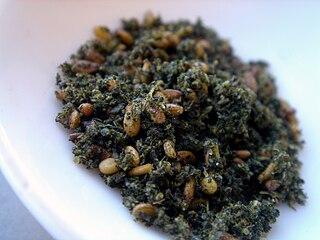
Za'atar is a culinary herb or family of herbs. It is also the name of a spice mixture that includes the herb along with toasted sesame seeds, dried sumac, often salt, as well as other spices. As a family of related Middle Eastern herbs, it contains plants from the genera Origanum (oregano), Calamintha, Thymus, and Satureja (savory) plants. The name za'atar alone most properly applies to Origanum syriacum, considered in biblical scholarship to be the ezov of the Hebrew Bible, often translated as "hyssop" but distinct from modern Hyssopus officinalis. Used in Levantine cuisine, both the herb and spice mixture are popular throughout the Mediterranean region of the Middle East.

The mountain gazelle or the Israeli mountain gazelle is a species of gazelle widely but unevenly distributed.

Blanford's fox is a small fox native to the Middle East and Central Asia. It is listed as Least Concern on the IUCN Red List.

Yair Lapid is an Israeli politician and former journalist who is the chairman of the centrist Yesh Atid party, and became the 14th prime minister of Israel on 1 July 2022. He previously served as the alternate prime minister of Israel and minister of Foreign Affairs from 2021 to 2022. He was Leader of the Opposition from 2020 to 2021, and Minister of Finance from 2013 to 2014.
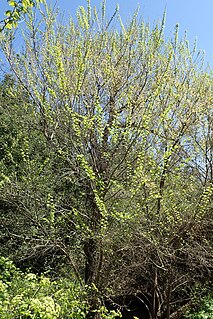
Ulmus minorsubsp.canescens is a small deciduous tree occasionally known by the common names grey elm, grey-leafed elm, and hoary elm. Its natural range extends through the lands of the central and eastern Mediterranean, from southern Italy, the islands of Sicily, Malta, Crete, Rhodes and Cyprus, to Turkey, and as far south as Israel, where it is now considered rare and endangered in the wild. The tree is typically found amidst the comparatively humid coastal woodlands and scrublands.

Israel, officially the State of Israel, is a country in Western Asia. It is situated on the southeastern shore of the Mediterranean Sea and the northern shore of the Red Sea, and shares borders with Lebanon to the north, Syria to the northeast, Jordan to the east, and Egypt to the southwest; it is also bordered by the Palestinian territories of the West Bank and the Gaza Strip to the east and west, respectively. Tel Aviv is the economic and technological center of the country, while its seat of government is in its proclaimed capital of Jerusalem, although Israeli sovereignty over East Jerusalem is unrecognized internationally.
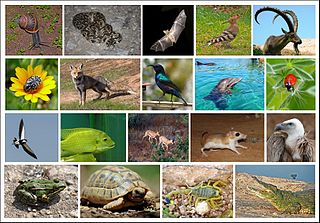
The wildlife of Israel includes the flora and fauna of Israel, which is extremely diverse due to the country's location between the temperate and the tropical zones, bordering the Mediterranean Sea in the west and the desert in the east. Species such as the Syrian brown bear and the Arabian ostrich have become extinct in Israel because of their loss of habitat. As of May 2007, 190 nature reserves have been established in Israel.

National parks of Israel are declared historic sites or nature reserves, which are mostly operated and maintained by the National Nature and Parks Authority. As of 2015, Israel maintains 81 national parks and more than 400 nature reserves, many of them in the occupied West Bank, that protect 2,500 species of indigenous wild plants, 32 species of fish, 530 species of birds and 100 species of mammals.

The Persian fallow deer is a deer species once native to all of the Middle East, but currently only living in Iran and Israel. It was reintroduced in Israel. It has been listed as endangered on the IUCN Red List since 2008. After a captive breeding program, the population has rebounded from only a handful of deer in the 1960s to over a thousand individuals.

Katinka's shrew is a species of mammal in the family Soricidae. It has been recorded from Israel, Syria, and Palestine, but it may now be extinct in Israel. It may also be present in southwestern Iran.

Naftali Bennett is an Israeli politician currently serving as the 3rd Alternate Prime Minister of Israel since 1 July 2022, having previously served as the 13th prime minister of Israel from 13 June 2021 to 30 June 2022. Bennett has served as the leader of the New Right party since 2018, having previously led The Jewish Home party between 2012 and 2018.

Manot Cave is a cave in Western Galilee, Israel, discovered in 2008. It is notable for the discovery of a skull that belongs to a modern human, called Manot 1, which is estimated to be 54,700 years old. The partial skull was discovered at the beginning of the cave's exploration in 2008. Its significance was realised after detailed scientific analysis, and was first published in an online edition of Nature on 28 January 2015. This age implies that the specimen is the oldest known human outside Africa, and is evidence that modern humans lived side-by-side with Neanderthals. The cave is also noted for its "impressive archaeological record of flint and bone artefacts". Geologically, it is an "active stalactite cave".



















